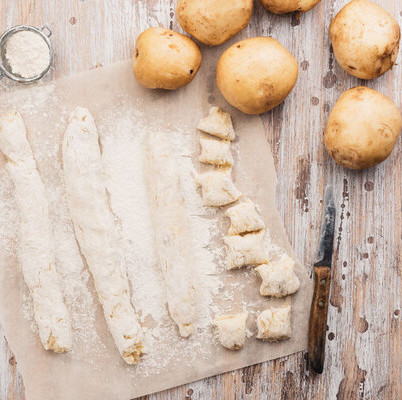Potato Flour
What is Potato Flour?
Potato flour is the fine ground white or off-white powder made from whole, peeled, dehydrated potatoes. It is commonly used in gluten-free baking in combination with other flours to ensure proper flavor, texture, dough development time and aroma.1
Baked goods such as sweet rolls made with potato flour tend to have a characteristic and desirable earthy flavor and crispy crust.1 Two varieties of potato flour are commercially available:1
- Potato granules: fine powder granules.
- Potato flakes: comes in pieces and crumbs.
Origin
Potato (Solanum tuberosum L.) was first cultivated in Peru in 8000 to 5000 BC. Today, potatoes are one of the five major crops in the world.1 Potato flour has been developed as a gluten-free alternative to wheat flour. Also, as a cost-effective ingredient to counter occasional high prices and scarcity of baking flour.1
Function
In baked goods, potato flour has several functions:1,2
- Liquid binding: attracts and holds water and aids in producing moist yeast bread and rolls.
- Thickener: increases the viscosity of many food systems including sauces and gravies.
- Color: provides a pale yellow color, and free sugars for Maillard’s browning reaction.
- Flavor: imparts a characteristic sweet and earthy flavor.
- Increases shelf life stability
- Texturizer: provides soft and tender crumb.
- Decreases dough development time.
Nutrition
Typical nutritional value of commercial potato flour per 100 g:3
| Component | Grams |
|---|---|
| Carbohydrates | 83.1 |
| Protein | 6.9 |
| Water | 6.52 |
| Minerals | 3.14 |
| Fat | 0.34 |
Potato flour provides 357 kcal per 100 gram. It contains considerable amounts of vitamin B6 and minerals, mainly iron, magnesium, calcium, potassium and zinc.1,2
Commercial production
Potato flour is commercially manufactured through the following production processes:1
- Conditioning: whole potatoes free from sprouting are washed using vertical or horizontal washing machines.
- Peeling: using high pressure steam peeling units.
- Slicing: peeled potatoes are cut into 10 – 15 mm thickness slices with mechanical slicers.
- Precooking: by boiling in water to prevent enzymatic browning and allowing the starch to gelatinize and protect cell membrane.
- Cooling: to 25 oC ( 77 oF) using cold water.
- Cooking or stewing: potatoes are cooked and cured in boiling water at 85-100 oC (185 – 212 oF) for 20 – 25 min.
Once cooled, potatoes go through different processes to become flakes or granules1
Potato flakes
- Crushing: cooked potatoes are mashed into a paste.
- Drying: flakes are made by drum drying with an air temperature of 145 oC (292 oF).
- Packaging
Potato granules
- Freeze – thaw: raw potatoes are frozen to – 20 oC (-40 oF) to -40oC (-40 oF), followed by thawing to 0 oC (32 oF) and subsequently to 5 oC (41 oF).
- Pre-drying: using hot air current at 93 oC (199.4 oF).
- Granulation: potatoes are granulated to 100 mesh particles in a pelletizer.
- Drying: at 85 oC (185 oF) .
- Packaging
Application
Several types of baking formulas can use potato flour including potato breads, rolls, cookies, dumplings, cakes and other desserts.1,2 Breads and rolls made with wheat flour partially substituted with potato flour show the following properties:
- A characteristic potato flavor
- Lighter and moister baked goods
- A larger loaf volume
- A lighter and fluffier texture
When working with potato flour the following considerations should be taken into account:
- For baked goods in general, substitute up to 25% of wheat flour with potato flour for optimal results.
- For yeast leavened products, substitute up to 15% of wheat flour with potato flour for optimal results.
- Higher concentrations of potato flour causes doughs to develop a gummy consistency.
- For gluten-free products, use potato flour in addition to other gluten-free flours such as rice flour.
Regulations
Because it’s made of whole potatoes that are considered safe for consumption, potato flour doesn’t have any specific FDA regulation.4
Similarly in the EU, potato flour doesn’t have a specific usage regulation.
References
- Lingling, C. U. I., Yange, T; Shuangqu, T; Wang, Y and Fuqiang, G.A.O. “Preparation of potato whole flour and its effects on quality of flour products: A review.” Grain & Oil Science and Technology 1.3 (2018): 145-150.
- Preedy, V. R., and Watson, R eds. Flour and breads and their fortification in health and disease prevention. Academic press, 2019.
- U.S. Department of Agriculture, Agricultural Research Service. FoodData Central, 01 April 2019. https://fdc.nal.usda.gov/fdc-app.html#/food-details/168446/nutrients . Accessed 11 December 2020.
- Food and Drug Administration (FDA). US Department of Health and Human Services. Commodity-specific Food Safety Guidelines For The Production, Harvest, Storage, And Packing Of Potatoes ,https://www.fda.gov/files/food/published/Commodity-Specific-Food-Safety-Guidelines-for-the-Production–Harvest–Storage–and-Packing-of-Potatoes.pdf , Accessed 11 December 2020.


